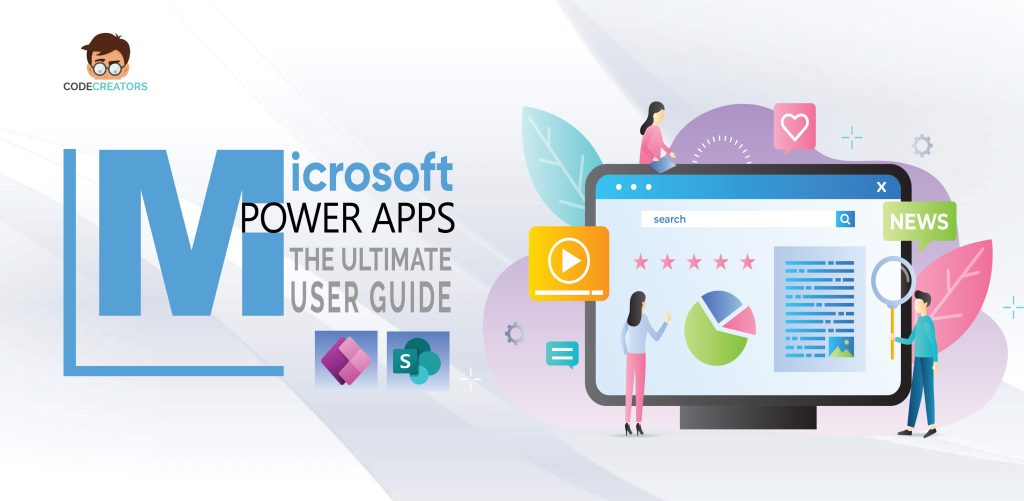Microsoft Power Apps – The Ultimate User Guide

Businesses in the modern digital world need solutions that allow them to quickly adjust to change, implement new ideas, and streamline existing processes. When it comes to low-code development platforms, Microsoft’s Power Apps has quickly become a frontrunner. This comprehensive user guide aims to unravel the power of Microsoft Power Apps, equipping you with the knowledge and skills needed to harness its capabilities effectively.
What is Microsoft Power Apps?
Overview of Power Apps As a Low-Code Development Platform
Microsoft Power Apps is a collection of cloud-based services made for developing unique, no-code, and low-code apps for a wide range of enterprise use cases. Users with and without coding experience are given the tools they need to create, modify, and deploy programs.
Key Features & Capabilities
Power Apps has several valuable features, such as an intuitive UI, the ability to integrate data, pre-built templates, and automation tools. Its flexibility in helping users build solutions for both desktop and mobile platforms makes it useful for a wide range of business problems.
Applications & Use Cases
Microsoft Power Apps finds applications in diverse scenarios, from automating simple tasks to developing complex enterprise solutions. It has many potential applications, including CRM software, PM software, and inventory management systems. Because of its flexibility, it may be used by businesses of any size or sector.
Getting Started with Microsoft Power Apps
Setting Up Your Power Apps Environment
To begin your journey with Power Apps, you’ll need to set up your environment, including signing up for a Power Apps subscription and configuring settings to match your organization’s requirements.
Navigating the Power Apps Interface
Power Apps features an intuitive interface that includes a canvas for app design, a tree view for app components, and a formula bar for writing expressions. Familiarizing yourself with these elements is essential for effective app development.
Accessing Templates & Connectors
Power Apps offers a variety of templates and connectors that simplify app creation. Templates provide a starting point for your app, while connectors enable seamless integration with data sources like Microsoft 365, SharePoint, and more.
Building Your First App
Choosing a Canvas or Model-Driven App
Power Apps offers two primary app types: Canvas and Model-Driven. Understanding their differences and choosing the right one for your project is crucial.
Creating An App Is A Simple Step-By-Step Process
In PowerApps, it is really easy to put together a simple app. You can easily structure your app using screens, link them together with data, and make them interactive by using powerful features. PowerApps encapsulates a structured, hands-on method of app development. It emphasizes simplicity and clarity, ensuring that even those new to app creation can follow along. By breaking down the process into manageable steps, it demystifies the complexities of app development.
You can start by building screens, progress to establishing essential data connections, and finally, seamlessly integrate interactive components. This approach encourages a gradual and comprehensive understanding of Power Apps, fostering confidence and competence among users. It’s a foundational approach that empowers individuals to embark on their app development journey with ease and confidence.
Customizing App Layout & Design
The quality of the user experience is greatly influenced by the design. Power Apps gives you the means to improve the aesthetics and usability of your app by changing things like its color scheme, fonts, and branding.
Data Integration with Power Apps
Connecting to Data Sources
With Power Apps, you may link up with local and remote databases, cloud services, and even on-premises systems. We’ll go into the processes of integrating, importing, and modifying information from various repositories.
Building Data-Driven Apps
Building data-driven apps is a pivotal aspect of modern application development. PowerApps allows crafting applications that rely on data as the driving force behind their functionality. To excel in this realm, one must master data modeling, establish robust data connections, and implement best practices. Data modeling entails structuring and organizing data in a way that aligns with the app’s requirements, ensuring efficient data retrieval and manipulation. Establishing secure and seamless data connections with various sources is another crucial element. Best practices encompass optimizing data flow, maintaining data integrity, and ensuring scalability, making data-driven apps not only functional but also reliable and adaptable.
Data Transformation & Manipulation
Data Transformation and Manipulation are fundamental capabilities within Power Apps that enable users to tailor data to their specific application needs. Power Apps equips developers with a versatile set of functions and tools, allowing data to be filtered, sorted, and transformed using expressions and formulas. With this functionality, users can refine, restructure, and optimize data sources, ensuring that information is presented in the most meaningful and actionable way within their applications. This empowers app creators to craft efficient and dynamic solutions that not only store data but also harness its full potential, enhancing the user experience and overall functionality of their apps.
Read also → How Microsoft Power Automate is Revolutionizing Business Process Automation?
Building Functions and Logic
Introduction to Power Apps Formulas
Introduction to Power Apps Formulas is a foundational aspect of harnessing the power of Microsoft Power Apps. Formulas serve as the backbone of Power Apps, facilitating the implementation of intricate business logic, intricate calculations, and essential data operations. These formulas and expressions are pivotal in determining how your applications interact with and manipulate data, making them a core component of app development. By mastering the basics of Power Apps formulas, you gain the ability to create dynamic, responsive, and intelligent applications that can automate tasks, validate inputs, and deliver a seamless user experience, all while enhancing your capabilities as an app developer.
Implementing Business Logic
Within the context of Power Apps, understanding and implementing business logic is essential. This empowers you with the knowledge and techniques to utilize formulas effectively. You can validate user inputs and automate crucial workflows, ensuring that your Power Apps behave precisely as intended. This capability is integral to crafting functional and efficient Power Apps that align with your organization’s specific requirements, delivering the desired user experience and enhancing overall functionality. In the realm of Power Apps development, mastering business logic is a crucial skill.
Creating Custom Functions
Custom functions are the secret sauce of app development. They enable you to encapsulate intricate logic into reusable components, streamlining your app’s efficiency. By using PowerApps, you can createe and effectively use custom functions, empowering you to enhance your app’s capabilities and optimize its performance.
User Interface Design
Designing User-Friendly Interfaces
A well-crafted user interface is the cornerstone of a positive user experience. MS PowerApps offers a wide range of design principles and best practices tailored to Power Apps. By understanding how to create user-friendly interfaces, you’ll enhance your Power Apps’ usability and appeal, resulting in more effective and engaging applications.
Adding Controls and Components
Power Apps offers a rich array of controls and components, empowering you to build interactive and dynamic applications. You can incorporate elements like buttons, forms, galleries, and more into your Power Apps. These additions elevate your app’s functionality, making it more feature-rich and user-friendly.
Responsive Design for Various Devices
In today’s diverse device landscape, ensuring your Power App seamlessly adapts to different screens is paramount. There are plenty of techniques available with MS PowerApps for designing responsive layouts that accommodate a multitude of devices. By mastering responsive design, your Power Apps will deliver consistent and optimal experiences across various screen sizes and resolutions.
Testing & Debugging
App Testing Strategies
Making sure the application works perfectly before releasing it to users requires thorough App testing. To guarantee your app’s robustness and user-friendliness, you may employ a variety of testing methodologies, such as manual testing, in which you carefully examine every element, automated testing, for efficiency and repeatability, and user testing, which gives vital insights from actual users.
Debugging Common Issues
Even the most well-designed apps can encounter hiccups. With better debugging skills to identify and resolve typical problems such as errors, performance bottlenecks, and user experience issues, you can ensure your app runs smoothly and efficiently.
Performance Optimization
App performance is a critical factor in user satisfaction. Acquiring essential tips and techniques to optimize your app’s speed and responsiveness, can guarantee a seamless and enjoyable user experience, regardless of the platform or device.
Sharing and Deployment
Sharing Apps with Colleagues & Users
When your app is polished and ready, it’s time to share its brilliance. Seamless sharing, covering various options and permission settings ensures secure and controlled access. Empower your colleagues and users to harness the app’s power effectively.
Deployment Options & Considerations
Navigating the deployment landscape is crucial. You can explore deployment considerations, whether you opt for cloud or on-premises deployment, address scalability, and implement robust version control strategies. Make informed decisions to ensure your app reaches its intended audience flawlessly.
App Version Control
Keeping a tight grip on different app versions is pivotal. You can look out for best practices for version control within Power Apps to ensure optimal performance. Maintain order, track changes, and ensure the stability and evolution of your app with confidence.
Advanced Power Apps Features
Integrating Power Automate
Supercharge your app’s functionality with seamless integration with Power Automate. This dynamic duo empowers you to automate workflows and processes effortlessly. Unlock the potential of enhanced automation and efficiency within your apps with this indispensable integration.
Power Apps Portals for External Users
Extend your app’s influence beyond boundaries. Power Apps Portals allow you to reach external users, including customers and partners, effortlessly. Learn the ropes of creating and managing portals for external access, opening up new avenues for interaction and collaboration.
Power Apps AI Builder for Advanced Capabilities
Explore the capabilities of AI Builder, a part of Power Apps, that enables you to add artificial intelligence features to your apps, such as object detection and sentiment analysis.
Tips & Best Practices
Tips for Efficient App Development
Efficiency is the lifeblood of successful app development in Power Apps. Here are five actionable tips to supercharge your productivity:
- Plan Thoroughly – Start with a clear plan. Define your app’s purpose, features, and user journey. A well-structured plan keeps you on track.
- Master Formulas – Invest time in understanding Power Apps formulas. Proficiency in formulas enables quicker and more efficient app development.
- Reuse Components – Create and reuse custom components. They speed up development and maintain consistency across your apps.
- Test Continuously – Test your app iteratively. This approach catches issues early and reduces debugging time later.
- Leverage Templates – Use Power Apps templates as a foundation. They provide a head start, saving valuable time.
Security & Data Protection Best Practices
Data security and privacy are paramount in Power Apps. Follow these best practices:
- Role-Based Access – Implement role-based security. Assign access rights only to necessary individuals.
- Data Encryption – Encrypt sensitive data both in transit and at rest to thwart unauthorized access.
- Authentication – Enforce strong authentication methods to validate user identities.
- Regular Audits – Conduct regular security audits to identify vulnerabilities and take corrective actions.
- Compliance – Stay updated with data protection regulations like GDPR and align your app with compliance requirements.
Staying Up to Date with Power Apps Updates
Keeping your Power Apps current is vital. Stay informed with these strategies:
- Microsoft Official Channels – Monitor official Microsoft communication channels, including blogs and newsletters, for the latest updates and announcements.
- Community Forums – Engage with the Power Apps community in forums and discussion groups. Users often share insights into new features.
- Webinars & Events – Attend webinars and events hosted by Microsoft. These provide deep dives into updates and best practices.
- Release Notes – Thoroughly review release notes accompanying updates. They offer detailed information on what’s new.
- Training & Certification – Consider formal training and certification to stay ahead of the curve.
By incorporating these practices into your Power Apps development routine, you can boost efficiency, fortify security, and remain at the forefront of innovation.
Conclusion
Microsoft Power Apps is a dynamic platform that empowers individuals and organizations to innovate and streamline their processes. With the knowledge and skills gained from this ultimate user guide, you are well-equipped to unlock the full potential of Power Apps. Embrace the future of app development and become a catalyst for positive change within your organization.


